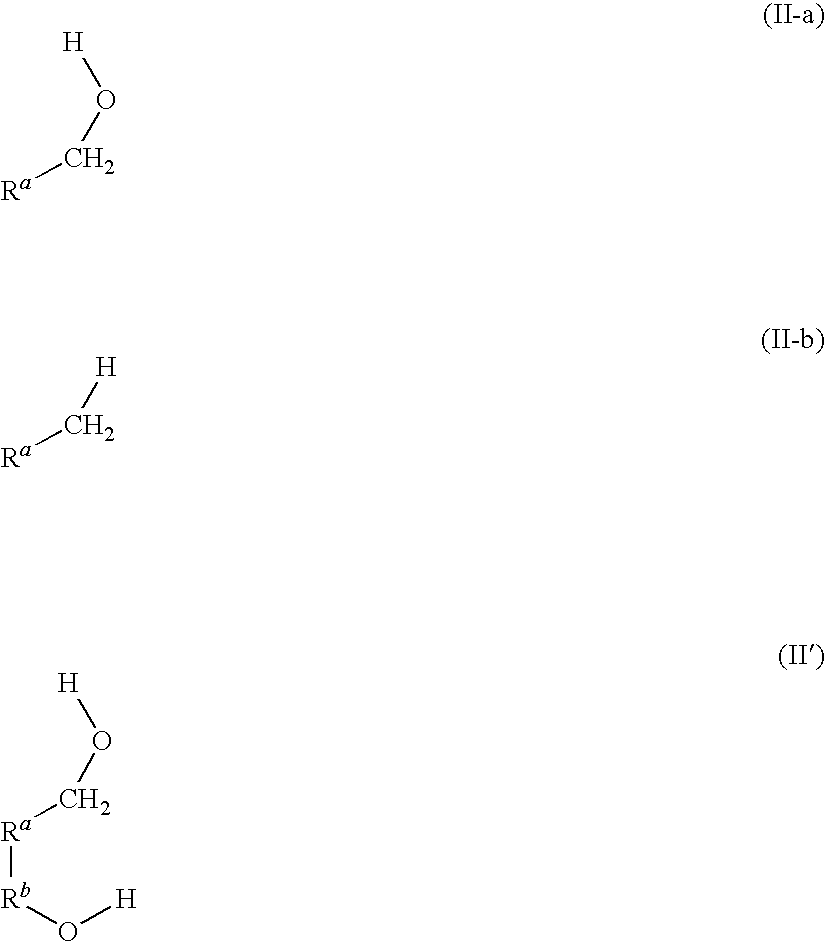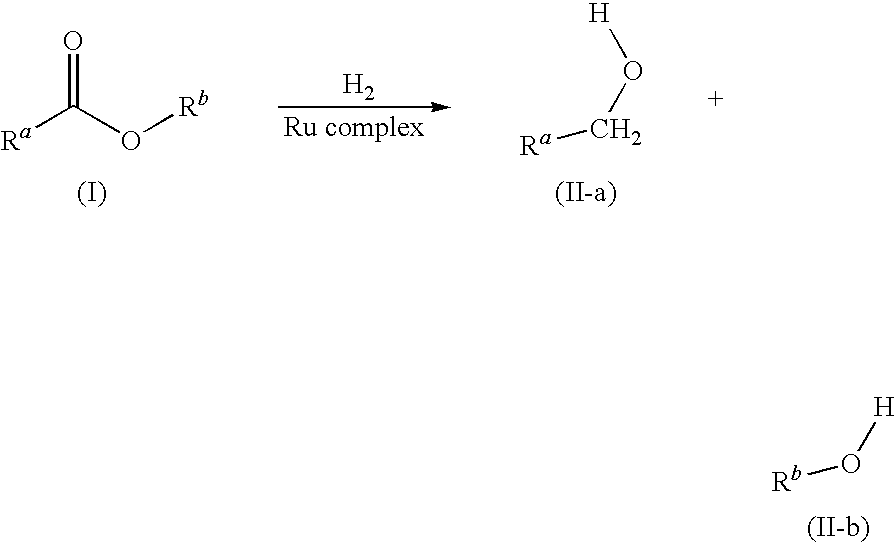Hydrogenation of esters with ru/bidentate ligands complexes
a technology of ru complexes and ligands, applied in the direction of organic compounds/hydrides/coordination complexes, physical/chemical process catalysts, ruthenium organic compounds, etc., can solve the problems of difficult tuning of the activity and the performance of the hydrogenation process, and large amounts of aqueous waste production
- Summary
- Abstract
- Description
- Claims
- Application Information
AI Technical Summary
Benefits of technology
Problems solved by technology
Method used
Image
Examples
example 1
A) Preparation of complexes [RuCl2(L-1)n], [RuCl2(L-2)2], [RuCl7(L-4)2]
a) Preparation of the Complex Dichloro bis[2-(Diphenylphosphino)ethylamine]Ruthenium ([RuCl2(L-1)2])
[0082]Under argon, a round-bottomed Schlenck flask, equipped with a magnetic stirring bar, was charged with RuCl2(PPh3)3 (418.6 mg, 0.436 mmol) and toluene (6 mL) Then under stirring, a solution of 2-(diphenylphosphino)ethylamine (201.6 mg, 0.879 mmol) in toluene (3 mL) was added, more toluene (3 mL) was added to rinse. Then the dark-brown solution was heated in an oil bath at 100° C. for six hours. The resulting yellow suspension was cooled to room temperature, and filtered under argon. The yellow solid was rinsed with toluene until the filtrate was colourless and then dried in-vacuo. The desired complex (258.4 mg, 0.41 mmol, 94%) was then collected as a pale-yellow solid. 31P{1H}-NMR analysis showed the presence of two species the major one being the trans-chloride-cis-phosphorous complex (75%) and the minor one ...
example 2
Catalytic Hydrogenation of Various Esters Using Complexes of Formula (1)
[0119]a) using pre formed complex
[0120]A typical catalytic hydrogenation using RuCl2(L-1)2 as pre-catalyst is described below with methyl benzoate as substrate:
[0121]Under argon, a solution of methyl benzoate (3.249 g, 24 mmol) in THF (2 mL) was added with a syringe, followed by more THF (2×1 mL), to a Keim autoclave equipped with a glass liner containing [RuCl2(L-1)2] (7.5 mg, 0.012 mmol, 0.05 mol %), solid NaOMe (128.2 mg, 2.4 mmol, 10 mol %) and THF (12.5 mL) The autoclave was pressurised with hydrogen gas at 50 bars and placed in a thermostatted oil bath set at 100° C. After 2 h 30 min, the autoclave was removed from the oil bath, and cooled in a cold-water bath. Then, the reaction mixture was diluted with citric acid 10% w / w (25 mL) and extracted with MTBE (100 mL). The organic phases was washed with aq. sat. NaCl (3×50 mL). Gas chromatography after silylation showed the following products: benzyl alcohol (...
example 3
Useful Temperature and Pressure Combinations
[0127]Different conditions are illustrated for the hydrogenation reduction reaction of methyl benzoate to benzyl alcohol catalysed by the following ligand:
[0128]The methyl benzoate concentration is 20 mmol, the complex concentration is 0.01 mmol, a base of NaOMe is used at a concentration of 1 mmol, with 10 mL of the solvent THF. The pressure was varied from 10 to 70 bar of hydrogen at 20 C, while the temperature was varied from 60° C. to 140° C. and the reaction conducted for a period of 1 to 4 hr. for various tests.
[0129]With the temperature held at 100° C., the pressures were varied from 10 to 70 bar, with GC yields of >99% achieved at 50 and 70 bar, and no variation of the H2 consumption rate. At 50 bar, the reaction proceeded rapidly and a 78% GC yield was obtained after even 15 min. At 30 bar, H2 consumption was slower, but a GC yield of 96% was achieved after 1 hour. At 10 bar, the GC yield dropped significantly and a GC yield of 47...
PUM
| Property | Measurement | Unit |
|---|---|---|
| temperatures | aaaaa | aaaaa |
| temperatures | aaaaa | aaaaa |
| pressures | aaaaa | aaaaa |
Abstract
Description
Claims
Application Information
 Login to View More
Login to View More - R&D
- Intellectual Property
- Life Sciences
- Materials
- Tech Scout
- Unparalleled Data Quality
- Higher Quality Content
- 60% Fewer Hallucinations
Browse by: Latest US Patents, China's latest patents, Technical Efficacy Thesaurus, Application Domain, Technology Topic, Popular Technical Reports.
© 2025 PatSnap. All rights reserved.Legal|Privacy policy|Modern Slavery Act Transparency Statement|Sitemap|About US| Contact US: help@patsnap.com



